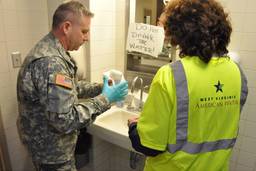
The Portland Montreal Pipe Line Company says it has “no plans” to reverse an oil pipeline and send Canadian tar sands to the harbor of Portland, Maine for export. But on Saturday, close to a thousand Maine residents and activists from across New England and as far away as Canada rallied at the city’s harbor to raise the alarm about that very possibility.
Dylan Voorhees with the Natural Resources Council of Maine (NRCM) told the crowd that oil companies having “no plan” in place to increase tar sands exports “is like me saying I have no plan for dinner tonight.” NRCM is concerned that Portland may lie in the path of an industry push to transport more tar sands oil overseas.
A pipeline from Alberta to Portland?
Environmental groups have reasons for alarm. In November 2012, Canadian oil giant Enbridge applied for a permit from the Canadian National Energy Board to reverse the flow of its Line 9 pipeline on the Ontario-Michigan border and transport tar sands to Montreal. Enbridge is the company responsible for spilling almost a million gallons of tar sands into the Kalamazoo River in 2010.
What’s more, the Enbridge-owned pipeline is part of a larger proposed pipeline project that would run all the way to Maine. Though Enbridge has denied that it plans to continue piping oil through New England, environmental groups charge that it is likely preparing to do just that. The original plan for the multi-pipeline “Trailbreaker” project also called for reversal of the flow of the Portland Montreal Pipe Line, which currently delivers light crude oil to Montreal, to allow it to carry tar sands from Montreal south for export. Activists charge that the companies have purposefully broken a large, controversial pipeline project into smaller parts in order to quell opposition.
Ted O’Meara, a spokesperson for the Portland Montreal Pipeline Company, told In These Times that the pipeline reversal plan was dropped in 2009 because “there was no market for it.” He added, “The mistake that people are making is saying that because this company in Canada is doing X it automatically means Y is going to happen in Portland. It is a possibility; the company has been very open that it could be a possibility, and if that should happen, you know, people aren’t going to just wake up one morning and find out the flow’s being reversed in the pipeline; there will be a process to do that.”
The company already possesses a presidential permit allowing it to cross an international border, but the permit makes no mention of tar sands. Since the pipeline already exists, however, its potential reversal would not necessarily be subject to an environmental review.
Congressperson Chellie Pingree (D-ME), whose district includes the Portland area, said during the rally that reversing the pipeline flow would pose serious environmental risks. “And I,” she told the crowd to wild cheers, “on behalf of my constituents in Maine, am going to ask the Obama administration to do a full environmental review of any attempts to pump tar sands through that old pipeline.”
Some at the rally were optimistic that Secretary of State nominee John Kerry, if confirmed, will be their champion. For a new pipeline crossing an international border, such as the Keystone XL proposal in the Midwest, the State Department must issue a report and a recommendation to the President, who makes the final decision. Kerry has long been one of the biggest advocates of addressing climate change in the Senate, and he could urge that a new environmental review be completed.
The growing movement against tar sands
In a report released by Greenpeace International earlier this month, tar sands were ranked as the fifth largest threat to the world’s climate, after several coal-related mega-projects. A sludge-like substance that must be mixed with hot water and chemicals before it can even flow through a pipeline, tar sands are the dirtiest form of oil with the biggest carbon footprint.
Frigid temperatures couldn’t quell protesters’ enthusiasm as they rallied first at the pipeline company’s headquarters downtown Portland, then marched several blocks to the waterfront. There, Portland Mayor Mike Brennan pointed to Casco Bay, shimmering in the sun next to where people were standing. It was the site of a 1996 spill that sent 180,000 gallons of oil into the water, an accident that he said has ongoing environmental impact. “You’re here today, I’m here today, and we’ll be here every day to make sure we never have a spill in Casco Bay again,” he said. The Portland City Council has also expressed its displeasure with the idea of reversing the flow of the 236-mile pipeline, which runs through Maine, New Hampshire and Vermont before crossing the border into Canada. The council will vote this week on a resolution that would ban the city’s use of tar-sands oil.
Portlander Jason Wentworth came to the rally with his daughter, and said it was her idea to create the cardboard tube pipeline with a “No Tar Sands” sign that he attached to his bike trailer. A potential spill is “an immediate concern,” he says, but beyond that, “the big concern is that my 5-year-old daughter needs to have a future, and we won’t have a future on this planet if we burn all the tar sands that are in Alberta.”
National climate group 350.org was well represented at the rally, as well as the Sierra Club, local organizations like Environment Maine and the Natural Resources Council of Maine. Lee Margolin, a local brewer, attended because he said he feared an oil spill in the now-pristine Crooked River, which he uses in his beer-making. “I’m just one of thousands of businesses in the region that depends on a clean environment and clean water,” he noted.
Jason Brown, a member of the Penobscot tribe from Maine, drummed and chanted along the march route. He said he was there to support the goals of the rally, and added that he also supports Idle No More. The Aboriginal-led movement has exploded across Canada and spread throughout the globe, highlighting how environmental degradation disproportionately impacts indigenous people. “The first nations stood up and fought against that, trying to rally everyone to join that fight,” Brown said, “because it’s not just a Native thing, it’s for everybody. The planet belongs to everybody, so it’s all of our responsibility to do our part to take care of it.” He ended the rally by gathering the crowd and chanting for a circle dance as an expression of that unity.
Many rally-goers said they plan to heed 350.org’s call to meet at the White House on February 17 for a mass demonstration to demand that President Obama make good on the climate change talk in his inaugural address by vetoing the permit for the Keystone XL pipeline.
Voorhees made clear that activists in Maine have an important role to play in the broader struggle against global warming. “The big oil companies want to get that tar sands out of Alberta to global energy markets,” he told the crowd. “… The only thing standing in their way is us.”





